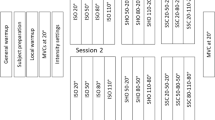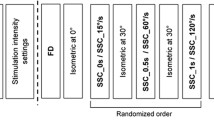Abstract
When an isometrically activated muscle is stretched or shortened the isometric steady-state force after the length change is increased (residual force enhancement) or decreased (force depression), respectively compared to a purely isometric contraction. This behavior has been observed consistently from the single sarcomere to the whole muscle level. However, the results for voluntary contractions in vivo are controversial and there are no studies for maximal voluntary contractions of medium sized muscles like the human ankle dorsiflexors. We investigated the effect of active muscle stretching and shortening for in vivo human tibialis anterior (n = 12) for maximal voluntary contractions for two magnitudes of stretching (15° and 30°) and two speeds of contraction (10°/s and 45°/s). Torques during stretches were higher compared to the purely isometric reference contractions and peak torques occurred prior to the end of the stretch. During the stretch, muscular activity decreased after peak torque had been reached for the high speed stretch experiments. In the steady-state phase following stretch, torque was increased for all experimental conditions but not for all time periods following stretch. The amount of residual force enhancement was independent of amplitude and speed of stretch. In the steady-state phase following shortening, torques were decreased compared to the isometric reference contractions and force depression was increased with increasing speeds of shortening.







Similar content being viewed by others
References
Abbott BC, Aubert XM (1952) The force exerted by active striated muscle during and after change of length. J Physiol 117:77–86
Cresswell AG, Löscher WN, Thorstensson A (1995) Influence of gastrocnemius muscle length on triceps surae torque development and electromyographic activity in man. Exp Brain Res 105:283–290. doi:10.1007/BF00240964
De Ruiter CJ, De Haan A (2003) Shortening-induced depression of voluntary force in unfatigued and fatigued human adductor pollicis muscle. J Appl Physiol 94:69–74
De Ruiter CJ, De Haan A, Jones DA, Sargeant AJ (1998) Shortening-induced force depression in human adductor pollicis muscle. J Physiol 507(2):583–591. doi:10.1111/j.1469-7793.1998.583bt.x
De Ruiter CJ, Didden WJM, Jones DA, De Haan A (2000) The force–velocity relationship of human adductor pollicis muscle during stretch and the effects of fatigue. J Physiol 526:671–681. doi:10.1111/j.1469-7793.2000.00671.x
Edman KAP, Elzinga G, Noble MI (1978) Enhancement of mechanical performance by stretch during titanic contractions of vertebrate skeletal muscle fibres. J Physiol 281:139–155
Edman KAP, Elzinga G, Noble MI (1982) Residual force enhancement after stretch of contracting frog single muscle fibers. J Gen Physiol 80:769–784. doi:10.1085/jgp.80.5.769
Ettema GJ, Meijer K (2000) Muscle contraction history: modified Hill versus an exponential decay model. Biol Cybern 83:491–500. doi:10.1007/s004220000190
Granzier HL, Pollack GH (1989) Effect of active pre-shortening on isometric and isotonic performance of single frog muscle fibres. J Physiol 415:299–327
Hahn D, Seiberl W, Schwirtz A (2007) Force enhancement during and following muscle stretch of maximal voluntarily activated human quadriceps femoris. Eur J Appl Physiol 100:701–709. doi:10.1007/s00421-007-0462-3
Herzog W (2004) History dependence of skeletal muscle force production: implications for movement control. Hum Mov Sci 23:591–604. doi:10.1016/j.humov.2004.10.003
Herzog W, Leonard TR (2002) Force enhancement following stretching of skeletal muscle: a new mechanism. J Exp Biol 205:1275–1283
Herzog W, Leonard TR, Wu JZ (2000) The relationship between force depression following shortening and mechanical work in skeletal muscle. J Biomech 33:659–668. doi:10.1016/S0021-9290(00)00008-7
Herzog W, Lee HD, Rassier DE (2006) Residual force enhancement in skeletal muscle. J Physiol 574(3):635–642. doi:10.1113/jphysiol.2006.107748
Hill AV (1938) The heat of shortening and the dynamic constants of muscle. Proc R Soc Lond B Biol Sci 126:136–195
Josephson RK, Stokes DR (1999) Work-dependent deactivation of a crustacean muscle. J Exp Biol 202:2551–2565
Joumaa V, Leonard TR, Herzog W (2008) Residual force enhancement in myofibrils and sarcomeres. Proc R Soc Lond B Biol Sci 275:1411–1419. doi:10.1098/rspb.2008.0142
Julian FJ, Morgan DL (1979) The effects of tension on non-uniform distribution of length changes applied to frog muscle fibres. J Physiol 293:379–392
Lee HD, Herzog W (2002) Force enhancement following muscle stretch of electrically stimulated and voluntarily activated human adductor pollicis. J Physiol 545:321–330. doi:10.1113/jphysiol.2002.018010
Lee HD, Herzog W (2003) Force depression following muscle shortening of voluntarily activated and electrically stimulated human adductor pollicis. J Physiol 551:993–1003. doi:10.1113/jphysiol.2002.037333
Lee HD, Suter E, Herzog W (1999) Force depression in human quadriceps femoris following voluntary shortening contractions. J Appl Physiol 87:1651–1655
Leonard TR, Herzog W (2005) Does the speed of shortening affect steady-state force depression in cat soleus muscle? J Biomech 38(11):2190–2197. doi:10.1016/j.jbiomech.2004.09.028
Marechal G, Plaghki L (1979) The deficit of the isometric titanic tension redeveloped after a release of frog muscle at a constant velocity. J Gen Physiol 73:453–467. doi:10.1085/jgp.73.4.453
Meijer K, Grootenboer HJ, Koopman BFJM, Huijing P (1997) Fully isometric length–force curves of rat muscle differ from those during and after concentric contractions. J Appl Biomech 13:164–181
Oskouei AE, Herzog W (2005) Observations on force enhancement in submaximal voluntary contractions of human adductor pollicis muscle. J Appl Physiol 98:2087–2095. doi:10.1152/japplphysiol.01217.2004
Pinniger GJ, Cresswell AG (2007) Residual force enhancement after lengthening is present during submaximal plantar flexion and dorsiflexion actions in humans. J Appl Physiol 102:18–25. doi:10.1152/japplphysiol.00565.2006
Rassier DE, Herzog W (2004) Active force inhibition and stretch induced force enhancement in frog muscle treated with BDM. J Appl Physiol 97(4):1395–1400. doi:10.1152/japplphysiol.00377.2004
Rassier DE, Herzog W, Wakeling JM, Syme D (2003) Stretch-induced, steady-state force enhancement in single skeletal muscle fibers exceeds the isometric force at optimal fibre length. J Biomech 37:1309–1316. doi:10.1016/S0021-9290(03)00155-6
Reeves ND, Narici MV (2003) Behavior of human muscle fascicles during shortening and lengthening contractions in vivo. J Appl Physiol 95:1090–1096
Rousanoglou EN, Oskouei AE, Herzog W (2007) Force depression following muscle shortening in sub-maximal voluntary contractions of human adductor pollicis. J Biomech 40:1–8. doi:10.1016/j.jbiomech.2005.12.002
Sugi H (1972) Tension changes during and after stretch in frog muscle fibers. J Physiol 407:215–229
Sugi H, Tsuchiya T (1988) Stiffness changes during enhancement and deficit of isometric force by slow length changes in frog skeletal muscle fibres. J Physiol 407:215–229
Webber S, Kriellaars D (1997) Neuromuscular factors contributing to in vivo eccentric moment generation. J Appl Physiol 83:40–45
Conflict of interest statement
The authors declare that they have no conflict of interest.
Author information
Authors and Affiliations
Corresponding author
Rights and permissions
About this article
Cite this article
Tilp, M., Steib, S. & Herzog, W. Force–time history effects in voluntary contractions of human tibialis anterior. Eur J Appl Physiol 106, 159–166 (2009). https://doi.org/10.1007/s00421-009-1006-9
Accepted:
Published:
Issue Date:
DOI: https://doi.org/10.1007/s00421-009-1006-9




